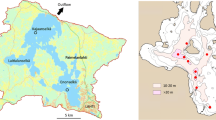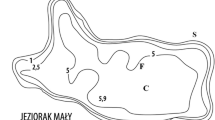Abstract
Bachmann et al. (1999) postulated that wind energy initiated, and has maintained, high turbidity in hypertrophic (mean chlorophyll a = 92 μg l−1) Lake Apopka, Florida (mean depth = 1.6 m; area = 12 500 ha). They asserted that the turbid condition was initiated by a hurricane in late 1947 that destroyed submersed plant beds and that high turbidity has since been maintained by wind-driven resuspension of fluid sediments. In their view, there has been sufficient light for re-establishment of submersed plants over about 38% of the lake bottom, but plant growth has been precluded by the fluid character of the sediments. They concluded that the restoration program of the St. Johns River Water Management District, which includes reduction of the phosphorus (P) loading rate, will not restore water clarity or submersed vegetation. An alternative explanation for Lake Apopka's turbid state is that it was initiated, and has been maintained, by excessive P loading that led to algal blooms and elimination of submersed vegetation through light limitation. The transition to the turbid state was contemporaneous with drainage of 7300 ha of the floodplain wetland to create polders for farming, beginning in the early 1940s. Lake P budgets indicate that drainage of the farms caused a seven-fold increase in the P loading rate (0.08 g TP m−2 yr−1 to 0.55 g TP m−2 yr−1). Paleolimnological analysis of lake sediments also indicates an increase in the P loading rate in mid-century, concomitant with the decline in submersed vegetation and the increase in phytoplankton abundance. After the increase in P loading, wind disturbance may have accelerated the transition to the turbid state; but, before the increase in P loading, wind disturbance was insufficient to elicit the turbid state, as evidenced by the stability of the clear-water state in the face of 14 hurricanes and 41 tropical storms from 1881 to 1946. Measurements of photosynthetically active radiation (PAR) indicate that light limitation has inhibited submersed plant growth except on the shallowest 5% of the lake bottom. Further, the correlation between the diffuse attentuation coefficient (K PAR) and chlorophyll a (CHLA) indicates that light limitation would be removed over about 82% of the lake bottom with a reduction in CHLA from 92 μg l−1 to 25 μg l−1. Recently, following a 40% reduction in the P loading rate, the mean total P (TP) concentration, mean CHLA, and total suspended solids fell by about 30% while mean Secchi depth increased by more than 20%. Submersed plant beds appeared in areas devoid of macrophytes for nearly 50 years. These improvements, during a period with no change in mean wind speeds measured at Lake Apopka, provide the strongest evidence that the turbid state has been maintained by excessive P loading and that the current restoration program, which combines P load reduction with planting and removal of planktivorous fish, will be effective.
Similar content being viewed by others
References
Bachmann, R. W., M. V. Hoyer & D. E. Canfield, Jr., 1999. The restoration of Lake Apopka in relation to alternative stable states. Hydrobiologia 394: 219–232.
Battoe, L. E., M. F. Coveney, E. F. Lowe & D. L. Stites, 1999. The role of phosphorus reduction and export in the restoration of Lake Apopka, Florida. In Reddy, K. R., G. A. O'Connor & C. L. Schelske (eds), Phosphorus Biogeochemistry in Subtropical Ecosystems. Lewis Publishers, New York: 511–526.
Canfield, D. E. & L.M. Hodgson, 1983. Prediction of Secchi depths in Florida lakes: Impact of algal biomass and organic color. Hydrobiologia 99: 51–60.
Canfield, D. E., K. A. Langeland, S. B. Linda & W. T. Haller, 1985. Relations between water transparency and maximum depth of macrophyte colonization in lakes. J. Aquat. Plant Manage. 23: 25–28.
Cooke, G. E., E. B. Welch, S. A. Peterson & P. R. Newroth, 1993. Restoration and Management of Lakes and Reservoirs. 2nd edn. Lewis Publishers, Boca Raton: 548 pp.
Chapra, S. & R. Canale, 1991. Long-term phenomenological model of phosphorus and oxygen for stratified lakes. Wat. Res. 25: 707–715.
Clugston, J. P., 1963. Lake Apopka, Florida, A changing lake and its vegetation. Florida Academy of Sciences 26: 168–174.
Dean, H. & E. Lowe, 1998. The Restoration Program for Lake Apopka, Florida, Volume 5, Proceedings of Water Environment Federation 71st Annual Conference and Exposition, October 1998, Orlando, FL: 313–316.
Jeppesen, E., P. Kristensen, J. P. Jensen, M. Sondergaard, E. Mortensen & T. Lauridsen, 1991. Recovery resilience following a reduction in external phosphorus loading of shallow, eutrophic Danish lakes: duration, regulating factors and methods for overcoming resilience. Mem. Ist. ital. Idrobiol. 48: 127–148.
Jones, J. R. & R.W. Bachmann, 1978. Trophic states of Iowa lakes in relation to origin and glacial geology. Hydrobiologia 57: 267–273.
Klinge, M. M., M. Grimm & S. Hosper, 1995. Eutrophication and ecological rehabilitation of Dutch lakes: presentation of a new conceptual framework. Wat. Sci. Technol. 31: 201–218.
Lowe, E. F., L. E. Battoe, D. L. Stites & M. F. Coveney, 1992. Particulate phosphorus removal via wetland filtration: an examination of potential for hypertrophic lake restoration. Envir. Manage. 16: 67–74.
Lowe, E. F., L. E. Battoe, M. F. Coveney & D. L. Stites, 1999. Setting water quality goals for restoration of Lake Apopka: Inferring past conditions. Lake and Reserv. Manage. 15: 103–120.
Marsden, M., 1989. Lake restoration by reducing external phosphorus loading: the influence of sediment phosphorus release. Freshwat. Biol. 21: 139–162.
Moss, B., J. Madgwick & G. Phillips, 1996. A Guide to the Restoration of Nutrient–enriched Lakes. Broads Authority, Norwich, U.K.: 180 pp.
Sas, H., 1989. Lake Restoration by Reduction of Nutrient Loading: Expectations, Experiences, Extrapolations. Academia Verlag Richarz, Sankt Augustin: 497 pp.
Scheffer, M., 1990. Multiplicity of stable states in freshwater systems. Hydrobiologia 200/201 (Dev. Hydrobiol. 61): 475–486.
Scheffer, M., 1998. Ecology of Shallow Lakes. Chapman and Hall, New York: 357 pp.
Scheffer, M. S., S. Hosper, M. L. Meijer, B. Moss & E. Jeppesen, 1993. Alternative equilibria in shallow lakes. Trends Ecol. Evol. 8: 275–279.
Schelske, C. L., 1997. Sediment and phosphorus deposition in Lake Apopka. Final Report. Special Publication SJ97-SP21, St. Johns River Water Management District, Palatka, FL.
Schelske, C. L., F. J. Aldridge & H. J. Carrick, 1992. Phytoplankton–nutrient interaction in Lake Apopka. Special Publication SJ92-SP9, St. Johns River Water Management District, Palatka, FL.
Schelske, C. L., M. F. Coveney, F. J. Aldridge, W. F. Kenney & J. E. Cable, 2000. Wind or nutrients: historic development of hypereutrophy in Lake Apopka, Florida. Limnology and Lake Management 2000+. Archiv für Hydrobiologie – Special Issues Advances in Limnology 55: 543–563.
Schelske C. L., C. M. Donar & E. F. Stoermer, 1999. A test of paleolimnological proxies for the planktonic/benthic ratio of microfossil diatoms in Lake Apopka. In Mayama, Idei & Koizumi (eds), 14th International Diatom Symposium, Tokyo, Japan. Koeltz Scientific Books, Koenigstein: 387–407.
Schelske, C. L. & W. F. Kenney, 2001. Model erroneously predicts failure for restoration of Lake Apopka, a hypereutrophic, subtropical lake. Hydrobiologia 448: 1–5.
Sheffield, C. & W. Kuhrt, 1970. Lake Apopka – its decline and proposed restoration. In Proceedings of Florida's Environmental Engineering Conference on Water Pollution Control. Florida Engineering and Experiment Station, Gainesville, FL: 130–146.
Welch, E. & G. Cooke, 1995. Internal phosphorus loading in shallow lakes: importance and control. Lake and Reserv. Manage. 11: 273–281.
Author information
Authors and Affiliations
Rights and permissions
About this article
Cite this article
Lowe, E.F., Battoe, L.E., Coveney, M.F. et al. The restoration of Lake Apopka in relation to alternative stable states: an alternative view to that of Bachmann et al. (1999). Hydrobiologia 448, 11–18 (2001). https://doi.org/10.1023/A:1017541010768
Issue Date:
DOI: https://doi.org/10.1023/A:1017541010768




